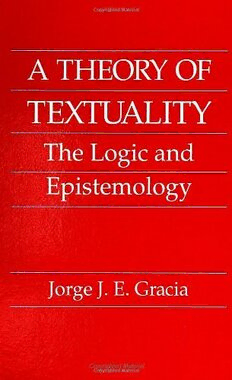
A Theory of Textuality: The Logic and Epistemology PDF
345 Pages·1995·1.148 MB·English
Most books are stored in the elastic cloud where traffic is expensive. For this reason, we have a limit on daily download.
Preview A Theory of Textuality: The Logic and Epistemology
Description:
This is the first comprehensive and systematic theory of textuality that takes into account the relevant views of both analytic and Continental thinkers and also of major historical figures. The author shows that most of the confusion surrounding textuality is the result of three factors: a too-narrow understanding of the category; a lack of a proper distinction among logical, epistemological, and metaphysical issues; and a lack of proper grounding of epistemological and metaphysical questions on logical analyses. The author begins with a logical analysis of the notion of text resulting in a definition that serves as the basis for the distinctions he subsequently draws between texts on the one hand and language, artifacts, and art objects on the other; and for the classification of texts according to their modality and function. The second part of the book uses the conclusions of the first part to solve the various epistemological issues which have been raised about texts by philosophers of language, semioticians, hermeneuticists, literary critics, semanticists, aestheticians, and historiographers.
See more
The list of books you might like
Most books are stored in the elastic cloud where traffic is expensive. For this reason, we have a limit on daily download.
